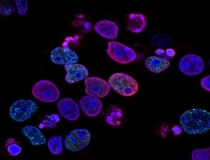The hips are made of solid joints that can withstand immense weight and pressure, but that doesn't mean they can't be damaged. Health conditions and injuries can result in hip pain, a debilitating ailment for those who suffer from it.
The good news is there are many forms of treatment for hip conditions ranging from non surgical to minimally-invasive procedures. The latest breakthrough comes in the form of hip stem cell treatments.
If you are curious about this new treatment method and want to know the list of diseases treated by stem cells, then keep reading. This blog also answers the question, “How can stem cells cure diseases, particularly in the hip area?”
What Are Stem Cells?
Stem cells are cells that can renew themselves and generate new cells for the body. They are the only component in the human anatomy with the natural ability to create new cell types. This means that under the right conditions, stem cells can develop into cells with a more specialized function, such as heart muscle, bone, blood and brain cells. This versatility is the answer to: “how can stem cells cure diseases” because it allows them to regenerate diseased tissues and organs.
Stem cells have two main types:
-
Embryonic stem cells: These cells originate from unused embryos that are products of in vitro fertilization procedures. The embryo is called a blastocyst at three to five days and has about 150 cells. Embryonic stem cells are pluripotent, meaning they can divide into more stem cells or become any cell in the body.
-
Adult stem cells: These stem cells come from fully developed tissues. Due to its maturity, physicians can only harvest a small number of cells. Adult stem cells also have limited capabilities in generating cell types. For example, stem cells from the bone marrow could develop into blood cells.
Why Is There Such an Interest in Stem Cells?
The interest surrounding stem cells has to do with their regenerative capabilities. Through them, researchers hope to increase understanding of how diseases occur and allow them to formulate the proper treatment to cure them. In addition, stem cells can be used as a form of regenerative medicine and have the potential to be grown for new tissue to be used in a transplant.
Stem cells can also be programmed into tissue-specific cells to test new drugs. For example, researchers can create nerve cells to try a new drug for a nerve disease.
What Diseases Can Be Cured With Stem Cells?
Knowing what diseases can be cured with stem cells is a great way to gauge its effectiveness. This new treatment method can now cure life-threatening conditions and malignancies, thanks to research.
The following is a list of some of the diseases treated by stem cells:
- Anemias (Aplastic Anemia, Congenital Dyserythropoietic Anemia, Paroxysmal Nocturnal Hemoglobinuria and Fanconi Anemia)
- Blood disorders or inherited red cell abnormalities (Blackfan-Diamond Anemia, Beta Thalassemia Major, Pure Red Cell Aplasia and Sickle Cell Disease)
- Bone Marrow Cancers (Plasma Cell Leukemia, Multiple Myeloma and Waldenstrom's Macroglobulinemia)
- Leukemia (Acute Lymphoblastic Leukemia, Acute Biphenotypic Leukemia, Acute Myelogenous Leukemia, Acute Lymphoblastic Leukemia, Acute Undifferentiated Leukemia, Acute Myelogenous Leukemia (AML), Chronic Lymphocytic Leukemia, Refractory Anemia with Excess Blasts, Juvenile Chronic Myelogenous Leukemia Refractory Anemia, Juvenile Myelomonocytic Leukemia and Chronic Myelomonocytic Leukemia)
- Lymphoma (Hodgkin's Lymphoma)
- Inherited Immune Disorders (Omenn Syndrome, Kostmann Syndrome, Bare Lymphocyte Syndrome, Ataxia-Telangiectasia, DiGeorge Syndrome, Common Variable Immunodeficiency, Lymphoproliferative Disorders, Leukocyte Adhesion Deficiency, Wiskott-Aldrich Syndrome, Acute Myelofibrosis, Myeloproliferative disorders, Polycythemia Vera, Agnogenic Myeloid Metaplasia, Essential Thrombocythemia, SCID (X-linked), SCID (ADA-SCID) and SCID with absence of normal B cells and T cells)
- Inherited immune and other system disorders (Cartilage-Hair Hypoplasia, Pearson's Syndrome, Gunther's Disease, Hermansky-Pudlak Syndrome, Systemic Mastocytosis and Shwachman-Diamond Syndrome)
- Inherited metabolic disorders (Hurler's Syndrome, Mucopolysaccharidoses, Scheie Syndrome, Sanfilippo Syndrome, Hunter's Syndrome, Morquio Syndrome, Maroteaux-Lamy Syndrome, Sly Syndrome, Mucolipidosis II, Adrenoleukodystrophy, Metachromatic Leukodystrophy, Krabbe Disease, Metachromatic Leukodystrophy, Gaucher Disease, Pelizaeus-Merzbacher Disease, Sandhoff Disease, Niemann-Pick Disease, Tay-Sachs Disease, Lesch-Nyhan Syndrome and Wolman Disease)
- Inherited platelet abnormalities (Congenital Thrombocytopenia and Glanzmann Thrombasthenia)
- Phagocyte disorders (Neutrophil Actin Deficiency, Chronic Granulomatous Disease, Chediak-Higashi Syndrome and Reticular Dysgenesis)
- Solid tumors (Medulloblastoma, Retinoblastoma and Neuroblastoma)
How Are Stem Cell Treatments Performed?
There are surgical procedures that allow doctors to view and operate in the hip joint without making a large incision through the skin, allowing for better and faster healing. However, many still wish to avoid hip surgery. If this is the case, stem cells can be utilized as a viable treatment option.
When it comes to hips, they can provide pain relief and tissue regeneration for the following conditions:
- Osteonecrosis
- Tendon injuries
- Ligament injuries
- Arthritis
- Fractures
In hip stem cell treatments, the doctor will use a non-surgical injection of a patient's own stem cells. The procedure is highly effective since the patient uses their own cells, diminishing the risk of rejection and infection.
Before the treatment, the physician will obtain the patient's stem cells from their bone marrow, typically from the iliac pelvic bone. The cells are then combined with white blood cells and platelets before being re-injected directly into the damaged hip tissue to accelerate its healing.
However, it's important to note that not every hip doctor can carry out this procedure effectively. Therefore, you must only seek treatment with a reputable specialty practice like the Chicago Cell Therapy & Regenerative Medicine by the American Hip Institute. They offer advanced and comprehensive hip stem cell treatments that promote healing of injured joints, ligaments, tendons and muscles. To schedule an evaluation, please visit Chicago Stem Cells.


 Thanks a lot for getting my hip right. Looking forward to a full recovery and a great season. Thanks again for everything.
Thanks a lot for getting my hip right. Looking forward to a full recovery and a great season. Thanks again for everything.










